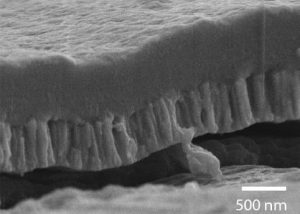
The top scanning electron microscope image (b) shows a cross section of the bioactive hydroxyapatite/YSZ coating without heat treatment. Note how the two layers are distinct. The bottom image (f) shows the coating after heat treatment. Note how the layers are now integrated.
Researchers from North Carolina State University have for the first time successfully coated polymer implants with a bioactive film. The discovery should improve the success rate of such implants – which are often used in spinal surgeries.
The polymer used in these implants, called PEEK, does not bond well with bone or other tissues in the body. This can result in the implant rubbing against surrounding tissues, which can lead to medical complications and the need for additional surgeries.
“We wanted to apply a bioactive coating that would allow the polymer implants to bond with surrounding tissues,” says Dr. Afsaneh Rabiei, an associate professor of mechanical and aerospace engineering at NC State and lead author of a paper on the research. “The challenge was that these coatings need to be heated to 500 degrees Celsius, but the polymer melts at 300 C. We’ve finally solved the problem.”
The first step in the new technique coats the implant with a thin film of yttria-stabilized zirconia (YSZ). The second step applies a coating of hydroxyapatite, which is a calcium phosphate that bonds well with bone. The researchers then heat the hydroxyapatite layer using microwaves. The YSZ layer acts as a heat shield, preventing the PEEK from melting. Meanwhile, the heat gives the hydroxyapatite a crystalline structure that makes it more stable in the body, meaning that the calcium phosphate will dissolve more slowly – promoting bonding with surrounding bone.
“We have received funding from the National Institutes of Health to proceed with animal testing to fine-tune this technique,” Rabiei says. “Then we will move on to clinical testing.”
Source: NC State University

















